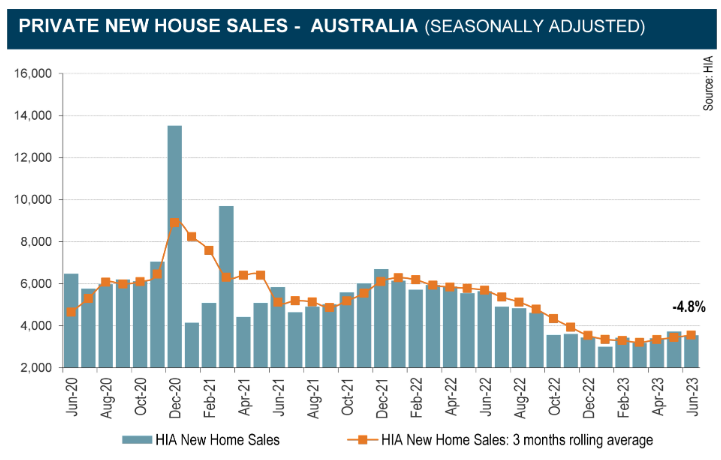After 18 months of widespread builder collapses, the leading indicators for housing construction continue to worsen.
Earlier this month, the Australian Bureau of Statistics (ABS) released data showing that the number of dwellings approved for construction has fallen to lows not seen since mid-2012:

Separate data on finance commitments for the construction of new homes also plummeted to an all-time low in May, down 74% from the peak in January 2021:

On Thursday, we go the trifecta with the Housing Industry Association (HIA) reporting that the number of new home sales “fell 4.8% in June, to remain at rock bottom levels”:

“This poor result in June leaves sales in the 2022/23 financial year down by 33.2% compared to the previous year”, HIA Chief Economist Tim Reardon said.
“The rise in the cash rate over the past year has seen a significant decline in the volume of new homes sales”.
“This will result in the least number of new homes commencing construction for more than a decade in 2024”, added Reardon.
“A significant number of existing projects are also being cancelled, as buyers find themselves unable to obtain finance after interest rates and construction costs continued upwards since they signed the contract”.
“This lack of new work entering the pipeline will result in fewer projects being commenced, and the volume of work under construction shrinking rapidly from late this year”.
“This will occur at the same time that Australia has a pre-existing shortage of housing, and overseas workers and students return to Australia in record numbers”, warned Reardon.
Treasury Secretary Steven Kennedy told the Senate Estimates Economics Committee in late May that the housing downturn will last until 2025, with investment in new homes likely to fall by 2.5% this year, 3.5% in 2023-24, and 1.5% in 2024-25.
Similarly, Oxford Economics Australia predicted that overall dwelling construction output would shrink by 21% over the three years to the financial year ended 2025.
Thus, the rate of new home supply will continue to shrink while Australia’s population expands at an unprecedented rate:

I reported previously that Australia needs 329 extra homes per day (net of demolitions) just to house the 1.5 million net overseas migrants projected by the federal budget to land in Australia over the five years to 2026-27.
Meeting this supply challenge will be impossible based on the above data.
As a result, Australia’s already acute housing shortages will worsen, pushing up rents and forcing thousands more Australians into homelessness.
The solution is to cut net overseas migration to a level that enables Australia to catch up on its accumulated housing and infrastructure shortages.
Historical levels of around 100,000 net overseas migration per year would be the appropriate target.

